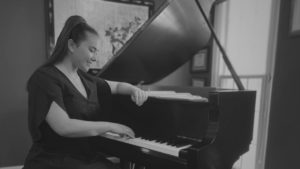2022 Advanced Piano Student Recital
Evangelina Meyer, Student of Hyeweon Gessner
By Mark Irchai, Levine Piano Faculty
 I’ve rarely felt a more palpable sense of warmth and kinship in the concert hall, than I did on the afternoon of Evangelina Meyer’s recital. There’s often this sense of stoic expectation when one enters a venue for a classical piano recital – but this was far from it. Friends and family were all gathered to support the artist, and Evangelina was conversing with them right up until the start of the performance. I’ve never seen an artist so intimately connected with their audience as Evangelina, and it was delightful to witness. I felt that this also had a lot to do with the deep connection between her and her teacher, Dr. Hyeweon Gessner. Both spoke at length about their personal friendship that had bloomed out of their student-teacher relationship during the course of over a decade of piano studies, and I had the opportunity to speak with Dr. Gessner at length about how much that friendship mattered to her, as well as to Evangelina, who leads a diverse life outside of piano studies, filled with numerous volunteering commitments, rowing, and even dedication to another instrument in the violin.
I’ve rarely felt a more palpable sense of warmth and kinship in the concert hall, than I did on the afternoon of Evangelina Meyer’s recital. There’s often this sense of stoic expectation when one enters a venue for a classical piano recital – but this was far from it. Friends and family were all gathered to support the artist, and Evangelina was conversing with them right up until the start of the performance. I’ve never seen an artist so intimately connected with their audience as Evangelina, and it was delightful to witness. I felt that this also had a lot to do with the deep connection between her and her teacher, Dr. Hyeweon Gessner. Both spoke at length about their personal friendship that had bloomed out of their student-teacher relationship during the course of over a decade of piano studies, and I had the opportunity to speak with Dr. Gessner at length about how much that friendship mattered to her, as well as to Evangelina, who leads a diverse life outside of piano studies, filled with numerous volunteering commitments, rowing, and even dedication to another instrument in the violin.
So it was no surprise that the program itself was filled with pieces that Evangelina held a strong connection towards. Clearly, as an artist, Evangelina thrives in music that is introspective, carried aloft by sensitivity and attention to nuance and detail. In these sonic worlds, she is a consummate artist of high caliber.
The program began with a roaring rendition of Chopin’s “Revolutionary” Etude, Op. 10, No. 12 – one that set the virtuosic stage for what was to come. It was daring, in every sense, to launch the program this way – and the risk paid off, as it cleared the air for the gorgeous Nocturne in D-flat Major, Op. 27, No. 2. Here, Evangelina felt much more at home, able to project a clear, singing resonance through its sweeping lines. She skillfully led the audience on the journey of this piece, a master of its form, with even the hills and peaks of sound being crafted and well-rounded. Nothing was harsh – everything was in its place, and the total offering was a delight.
Next came Beethoven’s Sonata in F-sharp Major, Op. 78, No. 24. A sonata in two movements, the first is a very multi-shaded work, opening with a short introduction that sets the stage for a pastoral pastiche that is so well-associated with mid to late Beethoven. Evangelina’s playing allowed the clarity of what comes next to shine through, with well-developed shading across the entirety of the movement. The second movement, unfortunately, was a weaker point for Evangelina. It’s a brilliant, cheerful dazzle of pyrotechnics, and there were some unfortunate, albeit slight, memory slips here. Ever the professional artist, however, Evangelina navigated out of them with sincerity and class.
The highlight of the program, for me, were the two preludes of Debussy – No. 3, “Le Vent dans la plaine/The Wind on the Plain” and No. 8, “La Fille aux cheveux de lin/The Girl with the Flaxen Hair”. In the same way Evangelina made her comfortable abode in Chopin’s Nocturne, Op. 27, No. 2, so it was here, too, that she was free to explore the colorful possibilities of the piano. The two preludes contrast well – the first mysterious, the second presenting an almost sunny, peaceful outlook. In the second prelude, in particular, she showed her enjoyment of a velvet-like sound, one that is not always extracted from a piano – but was done easily in her hands.
But it wouldn’t be a piano recital without the pyrotechnics of Liszt, displayed in the “Sonetto 104 del Petrarca”, and the infamous “Gnomenreigen” Etude. The Sonetto comes to the piano repertory as part of a set of three sonnets, originally conceived as works for voice and piano. Absent of the original poetry in its piano solo form, Evangelina’s playing nonetheless recaptured the vocal quality of the sonnet, with rich, soaring lines, and a full-bodied, almost oak-like tone pulled from the depths of the instrument. And “Gnomenreigen”, the Dance of the Gnomes, was sharp, light, and brisk, capturing the weightless movement of the gnomes in perfect, crisp, sparkling detail.
In short, this was a program that had deep roots in Evangelina’s sentiments and expressions of her multi-faceted life – a wonderful afternoon of music making, in a room full of music lovers. Evangelina will be moving on to studies at the College of William & Mary, where she will be majoring in international relations and minoring in music – where, I’m sure, music will continue to be an important place of personal introspection for years to come.
